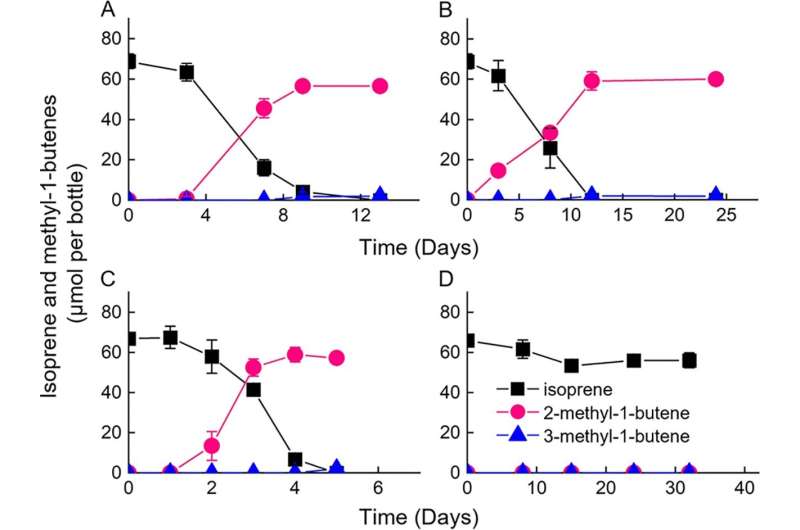This article has been reviewed according to Science X's and . have highlighted the following attributes while ensuring the content's credibility:
fact-checked
peer-reviewed publication
trusted source
proofread
Scientists investigate anaerobic degradation and conversion of the volatile hydrocarbon isoprene

Isoprene is the world's most abundant biogenic volatile hydrocarbon, and its annual contribution to greenhouse gas emissions is similar to the carbon dioxide equivalent of methane. However, the degradation and transformation of isoprene in the environment is still unclear.
The Environmental Microbial Ecology Group from the Institute of Applied Ecology of the Chinese Academy of Sciences (CAS) has been engaged in the research of biogeochemistry mediated by anaerobic microorganisms. In their recent study, Yang Yi and Jin Huijuan used sediment collected from Xihe River in Shenyang City as an inoculum source and established a microcosmic culture system for the anaerobic conversion of isoprene.
The researchers found that microorganisms in the anaerobic enrichment culture system could completely convert isoprene to 2-methyl-1-butene (97%) and 3-methyl-1-butene (3%). In addition, a new Acetobacterium strain, Acetobacterium wieringae strain Y, was the functional strain responsible for the anaerobic transformation of isoprene, and the strain Y utilized the Wood-Ljungdahl Pathway to reduce CO2 and generate acetic acid, while converting isoprene through a metabolic hydrogenation mechanism.
Furthermore, the researchers identified the ene-reductases that could be involved in the conversion of isoprene through comparative proteomic and genomic analyses. These enzymes, as biocatalysts, have strong industrial application prospects in the production of high-efficiency biofuels, pharmaceuticals and agricultural chemicals.
This study reveals that the acetogenic bacteria Acetobacterium wieringae are closely associated with the conversion processes of isoprene and CO2 in anaerobic environment, which is helpful to understand the environmental fate of isoprene-related carbon sources and assess the global carbon cycle flux models.
This work has been published in mBio, titled "Anaerobic biohydrogenation of isoprene by Acetobacterium wieringae strain Y."
More information: Huijuan Jin et al, Anaerobic Biohydrogenation of Isoprene by Acetobacterium wieringae Strain Y, mBio (2022).
Journal information: mBio
Provided by Chinese Academy of Sciences




















